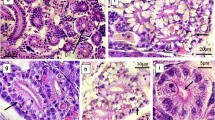Abstract
The impact of lead (Pb) on kidney histopathology of the frog Rana ridibunda was investigated. Female frogs were exposed for 4, 10 and 30 days to 14 ppm lead (as lead nitrate). All the lead concentrations and many histological changes were time dependent. Light microscopy of kidney revealed morphological changes mainly in the proximal convoluted tubule (PCT) cells. The most severe changes such as vacuolation, Perl's stained material, infiltration, brush border destruction and proximal tubule damage were detected in the animals exposed for 10 and 30 days. Karyomegaly was highest at 10-days exposure, probably as a result of intense stress caused by the lead. Some PCT in the 30-days-exposed animals were von Kossa's method positive, suggesting the presence of calcium. The possibility is discussed that some of these changes, such as karyomegaly and intranuclear inclusions, might be preneoplastic if lead was supplied at high concentrations and for long time.





Similar content being viewed by others
References
Boorman GA, Botts S, Bunton TE, Fournie JW, Harshbarger JC, Hawkins WE, Hinton DE, Jokinen MP, Okihiro MS, Wolfe MJ.(1997) Diagnostic criteria For degenerative, inflammatory, proliferative nonneoplastic and neoplastic liver lesions in Medaka (Oryzias latipes): consensus of a National Toxicology Program pathology working group. Toxicol Pathol 25:202–210
Ceruti R, Ghisleni G, Ferretti E, Cammarata S, Sonzogni O, Scanziani E. (2002) Wild rats as monitors of environmental lead contamination in the urban area of Milan, Italy. Environ Pollut 117:255–259
Davies BE. (1990) Lead. In: Alloway BJ (ed) Heavy metals in soils. Blackie, Glasgow, pp 177–196
Fowler BA (1996) The nephropathology of metals. In: Chang LW (ed) Toxicology of metals. Lewis, New York, pp 721–729
Goyer RA (1989) Mechanisms of lead and cadmium nephrotoxicity. Toxicol Lett 46:153–162
Hamada T, Nakano S, Iwai S, Tanimot A, Ariyoshi K, Koide O (1991) Pathological study on beagles after long-term oral administration of cadmium. Toxicol Pathol 19:138–147
Herak-Kramberger CM, Sabolic I (2001) The integrity of renal cortical brush-border and basolateral membrane vesicles is damaged in vitro by nephrotoxic heavy metals. Toxicology 156:139–147
Hilderbrand DC, Der RD, Griffin WT, Fahim MS (1973) Effect of lead acetate on reproduction. Am J Obstet Gynecol 115:1058–1065
Juncueira LCU, Bignolas G, Brentani RR (1979) Picrosirius staining plus polarization microscopy, a specific method for collagen detection in tissue sections. Histochem J 11:447–455
Lehr HA, Mankoff DA, Corwin D, Santeusanio G, Gown A (1997) Application of Photoshop-based image analysis to quantification of hormone receptor expression in breast cancer. J. Histochem Cytochem 45:1559–1565
Leussink BT, Slikkerveer A, Krauwinkel WJJ, van der Voet GB, de Heer E, de Wolff FA, Bruijn JA (2000) Bismuth biokinetics and kidney histopathology after bismuth overdose in rats. Arch Toxicol 74:349–355
Lock EA, Ishmael J (1998) The nephrotoxicity and hepatotoxicity of 1,1,2,2-tetrafluoroethyl-l-cysteine in the rat. Arch Toxicol 72:347–354
Loumbourdis NS, Vogiatzis AK (2002) Impact of cadmium on liver pigmentary system of the frog Rana ridibunda. Ecotoxicol Environ Saf 53:52–58
Loumbourdis NS, Kyriakopoulou-Sklavounou P, Zachariadis G (1999) Effects of cadmium exposure on bioaccumulation and larval growth in the frog Rana ridibunda. Environ Pollut 104:429–433
Lower WR, Kendall RJ (1990) Sentinel species and sentinel bioassay. In: Biomarkers of environmental contamination. Lewis, Boca Raton FL, pp 309–332
Mitsumori K, Shibutani M, Sato S, Onodera H, Nakagawa J, Hayashi Y, Ando M (1998) Relationship between the development of hepatorenal toxicity and cadmium accumulation in rats given minimum to large amounts of cadmium chloride in the long term: preliminary study. Arch Toxicol 72:545–552
Nolan CV, Shaikh ZA (1992) Lead nephrotoxicity and associated disorders: biochemical mechanisms. Toxicology 73:127–146
Oberley TD, Friedman AL, Moser R, Siegel FL (1995) Effects of lead administration on developing rat kidney II. Functional, morphologic and immunohistochemical studies. Toxicol Appl Pharmacol 131:94–107
Papadimitriou E, Loumbourdis NS (2003) Copper kinetics and hepatic metallothionein levels in the frog Rana ridibunda after exposure to CuCI2. Biometals 16:271–277
Pearse AGE (1985) Histochemistry, theoretical and applied, vol 2. Churchill Livingstone, London
Reimschuessel R, Bennet RO, May EM, Lipsky MM (1993) Pathological alterations and new nephron development in rainbow trout (Oncorhynchus mykiss) following tetrachloroethylene contamination. J Zoo Wildl Med 24:503–507
Roesijadi G, Robinson WE (1994) Metal regulation in aquatic animals: mechanisms of uptake, accumulation and release. In: Malins DC, Ostrander GK (eds) Molecular biology and biochemical approach to aquatic toxicology. Lewis, Boca Raton FL, pp 387–420
Stansley R, Roscoe DE (1996) The uptake and effects of lead in small mammals and frogs at a trap and skeet range. Arch Environ Contam Toxicol 30:220–226
Tanimoto A, Hamada T, Koide O (1993) Cell death and regeneration of renal proximal tubular cells in rats with subchronic cadmium intoxication. Toxicol Pathol 21:341–352
Taupeau C, Poupon J, Nome F, Lefevre B (2001) Lead accumulation in the mouse ovary after treatment-induced follicular atresia. Reprod Toxicol 15:385–391
Vogiatzis AK, Loumbourdis NS (1998) Cadmium accumulation in liver and kidneys and hepatic metallothionein and glutathione levels in Rana ridibunda after exposure to CdCI2. Arch Environ Contam Toxicol 34:64–68
Vogiatzis AK, Loumbourdis NS (1999a) A study of glycogen, lactate, total fats, protein and glucose concentration in the liver of the frog Rana ridibunda after exposure to cadmium for 30 days. Environ Pollut 104:335–340
Vogiatzis AK, Loumbourdis NS (1999b) Exposure of Rana ridibunda to lead—I. Study of lead accumulation in various tissues and hepatic δ-aminolevulinic acid dehydratase activity. J Appl Toxicol 19:25–29
Vogiatzis AK, Loumbourdis NS (2001) Exposure of Rana ridibunda to lead II. Impact of lead on various parameters of liver metabolism of the frog Rana ridibunda. J Appl Toxicol 21:269–274
Vyskocil A, Semecky V, Fiala Z, Cizkova M and Viau C (1995) Renal alterations in female rats following subchronic lead exposure. J Appl Toxicol 15:257–262
Wolke RE (1992) Piscine macrophage aggregates: a review. Annu Rev Fish Dis 2:337–343
Author information
Authors and Affiliations
Corresponding author
Rights and permissions
About this article
Cite this article
Loumbourdis, N.S. Nephrotoxic effects of lead nitrate in Rana ridibunda . Arch Toxicol 77, 527–532 (2003). https://doi.org/10.1007/s00204-003-0487-2
Received:
Accepted:
Published:
Issue Date:
DOI: https://doi.org/10.1007/s00204-003-0487-2




